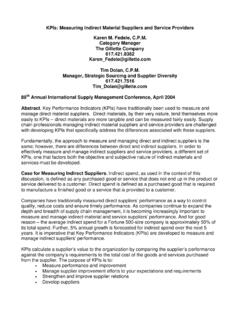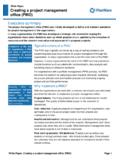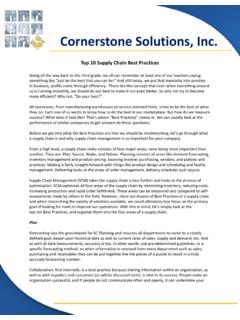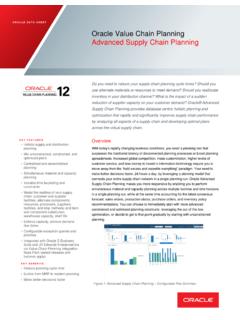Transcription of 10 Best Practices for Supply Management …
1 10 best Practices for Supply Management Organizations Robert J. Engel, Senior Practice Leader Resources Global Professionals - SCM Practice 713-403-1979: Jon Wesoky Senior Practice Leader Resources Global Professionals SCM Practice 703-610-3423: 95nd Annual International Supply Management Conference, April 2010 Abstract. During these unparalleled economic times, leaders of Supply Management organizations are receiving increased focus from their company's C-Suite and Leadership to contain costs and produce results. It is gratifying, as Supply Management professionals, that most companies are recognizing the importance of their Supply chains. This has resulted in Supply Management leaders taking the necessary steps to move towards implementing philosophies, methods, and processes that will result in their organizations being viewed as best of Class or Transformational. Supply Management organizational leadership have been challenged with taking the reins to lead their organization to new levels of achievement not only in saving money, but also in improving company performance, effectiveness, and efficiency.
2 This session will focus on 10 specific Practices that should be embraced. Objective. To provide thoughtful and meaningful information regarding the key strategies and Practices to build a road map for becoming a more effective Supply chain organization . 10 best Practices for Supply Management Organizations This manuscript does not pretend to have a precise roadmap to follow in order to achieve desired Supply chain maturity and excellence. It does, however, offer insight as to the key attributes that should be adopted or addressed. The sequence order of these 10 do not specify or recommend a higher vs. lower importance ranking, but does offer a systematic sequence when developing a scorecard of effectiveness in building a best of class Supply chain organization . That said, lets examine these 10 initiatives. The ten are: 1. Establish a governing council. 2. Align and staff the Supply chain organization . 3. Utilize technology and procure to pay.
3 4. Set the strategic sourcing strategy. 5. Establish key supplier alliances. 6. Manage total cost of ownership. 7. Establish processes and controls. 8. Manage compliance and risk. 9. Optimize company owned inventory 10. Establish green initiatives and social responsibility. 1. Establish a governing council. As our first listed best practice, the establishment of a Supply Chain Governing Council is absolutely critical for the success of the company s Supply chain effectiveness. Who should be on this council?? Well, certainly the Supply chain organization leadership but more importantly it should consist of members of the executive group, key internal business unit leaders, and other influential company leaders. Such a council is so very valuable in that it: Gives direction to and helps align Supply chain strategy. It is very important that the Supply chain strategy be in direct correlation with the company strategy.
4 Often we see Supply chain organizations that are struggling for recognition because their objectives differ from the stated company objectives. The governing council can provided constant and consistent validation of strategy. Helps in removing barriers within the organization . Every company has these barriers that are usually those individuals or organizations who don t see or accept the value that Supply chain can provide. The operational members of the council can help address, remove, or steer the Supply chain efforts in such a manner to ensure that the Supply chain organization is given the opportunity to perform. Fosters internal organizational buy-in that is needed to be an effective service organization . Once the organization sees that the executive leadership is fully embracing the Supply chain organization , it is likely the key business unit stakeholders will follow suit and will be more willing to work with and support the Supply chain efforts and initiatives.
5 Provides a needed forum for early involvement. By having an active governing council, the internal business unit leaders can provide the Supply Management leadership with information regarding future strategies and projects. 2. Align and staff the Supply chain organization . Once the Supply chain council has set a strategy, the Supply chain organization must be prepared to execute. One significant challenge has been how to organize the function to realize the full potential and benefit of being an effective organization . Certainly, organizational structures will take on different looks from company to company. For some companies, it is well served to embed a proficient Supply Management professional in the internal business unit, and for others the most effective way is to provide a more centralized approach. And a hybrid approach of these two would also merit consideration. But a leading strategy of progressive companies is in centralizing strategy to gain consensus, with decentralized execution to improve service.
6 Regardless, the emerging trend in Supply Management organizational effectiveness is to roll up under the Supply chain leader the functions of Sourcing, Materials Management , Logistics, Forecasting/Demand planning, and Contract Management . The following organizational chart is not listed to suggest this chart is correct for all companies, but more so to give a pictorial view of what today s modern organization may look like. Correctly staffing the organization is vital to success. As the Supply chain function evolves and as we have matured as a vital part of our company s Management team, the overall SCM organization skills and knowledge must also be elevated. Leadership is desiring their teams to be more strategically focused, and less concerned about transactional ability. Further, the skill set requirements include: Strong interpersonal communication Strategic thinking Value oriented Relationship Management skills (both internally and externally) 3.
7 Technology and purchase to pay. best of class Supply Management organizations are recognizing the importance of technology and an efficient purchase to pay process. The reality is that technology is NOT just a Supply chain thing it is how company s today are conducting their business. ERP systems are being implemented and updated and a general feeling is that we are feeding the system when in reality the system needs to help us become more effective. best of class companies put in place the strategy and working mechanisms to get the very most out of their technology. As we continue to migrate to a global economy, the need for connectivity has never been greater. Data is another area that technology can greatly assist the Supply Management function. Unfortunately, most organizations have difficulty retrieving the type of data ( spend data) needed to make sound strategy and business decisions. Once again, best of class means Supply CHAIN LEADER PROCUREMENT LOGISTICS Management KAP-Vendors $ Volume Driven Q A Spend Areas-Future CORE Commodities Warehousing Inventory Transportation Environmental Reverse Logistics STRATEGIC SOURCING TACTICAL PURCHASING KAP = Key Alliance Partners CONTRACT Management Release orders-KAP s Spot Orders Non-Repetitive Orders NON-CORE Commodities Supply Chain Management organization Supply Chain Council Strategy Demand & Forecasting Process Review Technology Efficiencies finding a way to make technology produce the type of data that is beneficial without having to perform various work-arounds to extract and see the required data.
8 4. Set the strategic sourcing strategy. Strategic sourcing is a cornerstone of Supply Management . A successful collaborative strategic sourcing initiative not only ensures availability of supplies, but will result in the obtainment of overall lower total cost, streamlined processes, and increased responsiveness to customers changing needs. Strategic sourcing is not just a purchasing department initiative. It requires input from all functional areas such as finance and accounting, engineering, operations, maintenance, safety/health/ & environmental, quality assurance, and internal business unit team members that will contribute to the initiative s success. That s the essence of the collaborative side and the success of achieving true buy-in from our internal clients is getting them involved in the decision making process. After all, aren t our business units our customers?? And shouldn t they be actively involved in not only assisting with the decision making process, but more importantly giving key feedback and information regarding their objectives and strategies?
9 5. Establish key supplier alliances. The ultimate success of strategic sourcing depends on the team s ability to select key suppliers and to manage supplier alliances for critical spend areas. Perhaps one weakness in most strategic sourcing efforts is the follow through with the selected suppliers. In most circles today, this final step has traditionally been called supplier relationship Management . In reality, perhaps a more appropriate term should be Alliance Management since supplier Management has a tendency to infer one way communication (telling the supplier how to do it) vs. the correct mindset of two way communication which requires both buyer and seller to team together (Alliance) to manage the relationship. A primary goal of most Supply chain organizations is to channel their relationships with their key suppliers so that maximum focus can be achieved for the major or core spending areas. With a well founded and fundamentally sound Alliance Management program in place, Supply Management organizations are equipped to use the talents of the Supply base to not only create sustained value, but constantly seek continuous improvement.
10 The four primary objectives of an effective Alliance Management program with key suppliers are: 1. Provide a mechanism to ensure that the relationship stays healthy and vibrant, 2. Create a platform for problem resolution, and 3. Develop continuous improvement goals and objectives with the objective of achieving value for both parties. 4. Ensure that performance measurement objectives are achieved 6. Manage total cost of ownership. Strategic sourcing shifts the company s and team s focus from just looking at the purchase price, to understanding the dynamics of the total cost of owning or consuming a product or service. For significant spend areas, procurement teams are abandoning the outmoded practice of receiving multiple bids and selecting a supplier simply on price. Instead, they consider many other factors that impact the total cost of ownership. In fact, acquisition costs accounts for only 25% to 40% of total cost for most products and services.














